Search the Special Collections and Archives Portal
Search Results
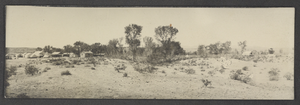
Photograph of a railroad builders' camp, Nevada, circa 1903-1904
Date
1903 to 1904
Archival Collection
Description
A view of a railroad builders' camp for the S.P. (San Pedro), L.A. (Los Angeles) & S.L. (Salt Lake) line between Caliente and Las Vegas in southern Nevada.
Image
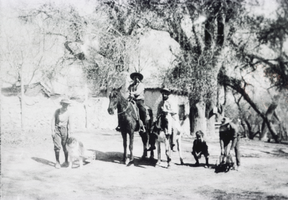
Photograph of men at the Mormon Fort, Las Vegas, Nevada, 1909
Date
1909
Archival Collection
Description
Men and a boy, horses and dogs outside of buildings at the Mormon Fort, Las Vegas, Nevada. Site Name: Las Vegas Mormon Fort (Las Vegas, Nev.)
Image

Charles Rozaire Nevada State Museum narrative memoir and other records
Date
1962-07-26
1962-07-25
1962
2005-12-11
2013-20-14 (approximate)
2005-09-06
1962-01
1962-09-19
2007-11
2005-09-04 to 2008-08-02
Archival Collection
Description
July 5, 1962, December 4, 1963. Charles Rozaire's handwritten memoir of his career at the Nevada State Museum. Also included in this folder are newspaper clippings, The Newsletter of the Archaeological Survey Association of Southern California from the summer of 1962, a Sierra Club newsletter from late 2013 or early 2014, and an obituary page about Richard Shutler Jr. in the Society for American Archaeology Record magazine.
Text
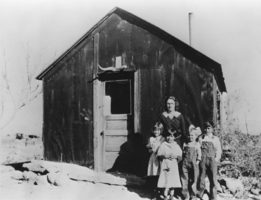
Schoolhouse at Eden Creek, Kawich Mountains, Nevada: photographic print
Date
1934
Archival Collection
Description
From the Nye County, Nevada Photograph Collection (PH-00221) -- Series VII. Other areas in Nye County -- Subseries VII.C. Fallini Family (Twin Springs, Nevada). The school was located in front of the stone house, which belonged to Giovanni Fallini. The children are, Hazel Aragoni, Alice Pete, Dick Pete, and Lawrence Aragoni (identified from left to right); the teacher is Helen Humphrey.
Image
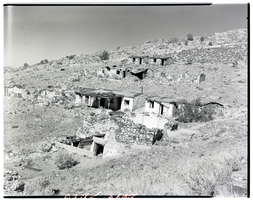
Film transparency of a ghost town, Delamar, Nevada, 1956
Date
1956
Archival Collection
Description
A view of some of the abandonded buildings on a hillside in Delamar, Nevada. One of the structures has a covered porch Delamar, Nevada, nicknamed The Widowmaker, is a ghost town in central eastern Nevada, USA along the east side of the Delamar Valley. During its heyday, primarily between 1895 and 1900, it produced $13.5 million in gold. In 1889, prospectors John Ferguson and Joseph Sharp discovered gold around Monkeywrench Wash. A mining camp was then born west of the Monkeywrench Mine. It was called Ferguson. In April 1894, Captain Joseph Raphael De Lamar bought most of the important mines in the area and renamed the Ferguson camp as Delamar. In the same year, a newspaper called the Delamar Lode began publication and a post office was opened. Soon, the new settlement boasted more than 1,500 residents, a hospital, an opera house, churches, a school, several businesses and saloons. Most buildings were made of native rock. By 1896, the Delamar mill was handling up to 260 tons of ore daily. Water for the camp was pumped from a well in Meadow Valley Wash, some twelve miles away. Supplies and materials traveled even further, by mule team over mountainous terrain from the railroad head at Milford, Utah, which was 150 miles from Delamar. Silicosis The gold in the Delamar mines was embedded in quartzite which when crushed created a fine dust. Miners breathing the dust often developed silicosis and the town became known as a "widow-maker." Many ruins now stand semi-intact in the Delamar ghost town region. Foundations can easily be seen from adjacent hills. There are two graveyards, which have been vandalized. The area is honeycombed with mines and mineshafts, but in recent years the main shaft has been blasted closed. Wild horses roam the area. The nearby dry lake is known to pilots as Texas Lake because its outline resembles the state of Texas.
Image
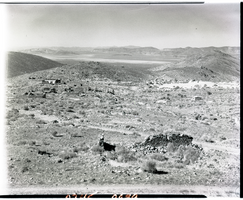
Film transparency of a ghost town, Delamar, Nevada, 1956
Date
1956
Archival Collection
Description
A view of some of the abandonded buildings in Delamar, Nevada, taken from a nearby hill. Delamar, Nevada, nicknamed The Widowmaker, is a ghost town in central eastern Nevada, USA along the east side of the Delamar Valley. During its heyday, primarily between 1895 and 1900, it produced $13.5 million in gold. In 1889, prospectors John Ferguson and Joseph Sharp discovered gold around Monkeywrench Wash. A mining camp was then born west of the Monkeywrench Mine. It was called Ferguson. In April 1894, Captain Joseph Raphael De Lamar bought most of the important mines in the area and renamed the Ferguson camp as Delamar. In the same year, a newspaper called the Delamar Lode began publication and a post office was opened. Soon, the new settlement boasted more than 1,500 residents, a hospital, an opera house, churches, a school, several businesses and saloons. Most buildings were made of native rock. By 1896, the Delamar mill was handling up to 260 tons of ore daily. Water for the camp was pumped from a well in Meadow Valley Wash, some twelve miles away. Supplies and materials traveled even further, by mule team over mountainous terrain from the railroad head at Milford, Utah, which was 150 miles from Delamar. Silicosis The gold in the Delamar mines was embedded in quartzite which when crushed created a fine dust. Miners breathing the dust often developed silicosis and the town became known as a "widow-maker." Many ruins now stand semi-intact in the Delamar ghost town region. Foundations can easily be seen from adjacent hills. There are two graveyards, which have been vandalized. The area is honeycombed with mines and mineshafts, but in recent years the main shaft has been blasted closed. Wild horses roam the area. The nearby dry lake is known to pilots as Texas Lake because its outline resembles the state of Texas.
Image

Film transparency of a ghost town, Delamar, Nevada, 1956
Date
1956
Archival Collection
Description
Some of the abandonded buildings in Delamar, Nevada. A tailing pile from one of the mines is visible in the center of the photograph. A stone structure is visible on the right side of the photograph. Delamar, Nevada, nicknamed The Widowmaker, is a ghost town in central eastern Nevada, USA along the east side of the Delamar Valley. During its heyday, primarily between 1895 and 1900, it produced $13.5 million in gold. In 1889, prospectors John Ferguson and Joseph Sharp discovered gold around Monkeywrench Wash. A mining camp was then born west of the Monkeywrench Mine. It was called Ferguson. In April 1894, Captain Joseph Raphael De Lamar bought most of the important mines in the area and renamed the Ferguson camp as Delamar. In the same year, a newspaper called the Delamar Lode began publication and a post office was opened. Soon, the new settlement boasted more than 1,500 residents, a hospital, an opera house, churches, a school, several businesses and saloons. Most buildings were made of native rock. By 1896, the Delamar mill was handling up to 260 tons of ore daily. Water for the camp was pumped from a well in Meadow Valley Wash, some twelve miles away. Supplies and materials traveled even further, by mule team over mountainous terrain from the railroad head at Milford, Utah, which was 150 miles from Delamar. Silicosis The gold in the Delamar mines was embedded in quartzite which when crushed created a fine dust. Miners breathing the dust often developed silicosis and the town became known as a "widow-maker." Many ruins now stand semi-intact in the Delamar ghost town region. Foundations can easily be seen from adjacent hills. There are two graveyards, which have been vandalized. The area is honeycombed with mines and mineshafts, but in recent years the main shaft has been blasted closed. Wild horses roam the area. The nearby dry lake is known to pilots as Texas Lake because its outline resembles the state of Texas.
Image

Helldorado Parade, Las Vegas, Nevada: photographic print
Date
1910 (year approximate) to 1945 (year approximate)
Archival Collection
Description
From the Elizabeth Harrington Photograph Collection (PH-00291). Inscription with image reads: "Early Helldorado Parade down Fremont Street. Theme of float 'Old Woman in a Shoe'. Small girl sitting near the far left with bow in her hair is Janice Harrington, daughter of Mr. And Mrs. John Harrington. Others not identified." - E(lizabeth) Harrington (Photo by Western Studio, Las Vegas, Nev.) "Western Studio 227 South Fifth Te 825 Las Vegas, Nevada Original owener and photographer Ray E. Vincent" stamp on verso.
Image
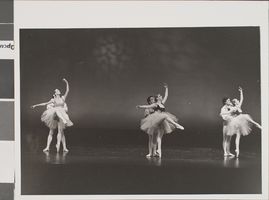
Photograph of Nevada Dance performance, Las Vegas, circa 1970s-1980s
Date
1970 to 1989
Archival Collection
Description
Nevada Dance Theatre performance.
Image
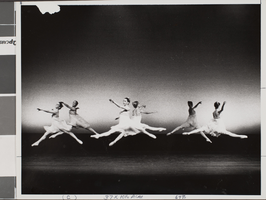
Photograph of Nevada Dance performance, Las Vegas, circa 1970s-1980s
Date
1970 to 1989
Archival Collection
Description
A production of the Nevada Dance Theatre
Image
Pagination
Refine my results
Content Type
Creator or Contributor
Subject
Archival Collection
Digital Project
Resource Type
Year
Material Type
Place
Language
Records Classification
